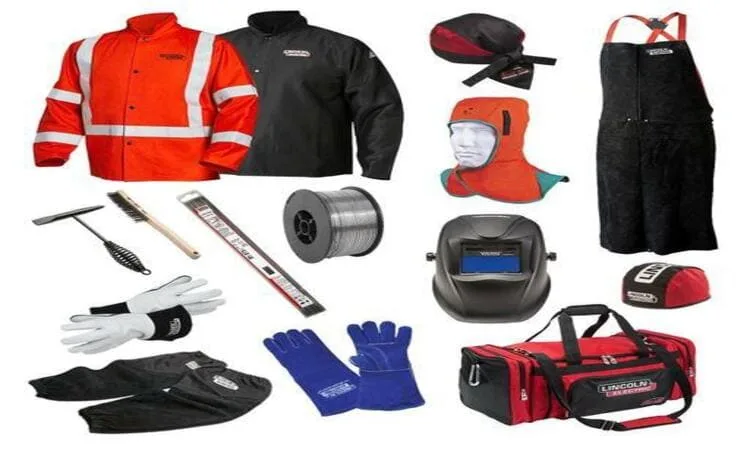What is PPE?
PPE stands for Personal Protective Equipment. It refers to specialized clothing, equipment, or gear that is designed to protect individuals from various workplace hazards, environmental dangers, or infectious materials. The primary purpose of PPE is to minimize the risk of injury or illness to the wearer by creating a barrier between the person and the potential hazards.
What is PPE in Welding?
Personal Protective Equipment (PPE) is of utmost importance in welding due to the inherent hazards associated with the welding process. Welders work with high temperatures, intense light, sparks, and harmful fumes, which can pose significant risks to their health and safety. Here are the reasons why PPE is crucial in welding:
- Protection against burns and sparks
- Eye protection
- Respiratory protection
- Hearing protection
- Skin and body protection
- Protection against electric shock
- UV radiation protection
Overall, PPE plays a critical role in safeguarding welders’ health and well-being, reducing the risk of workplace injuries, and ensuring a safe working environment during welding operations. It is essential for employers to provide appropriate PPE and ensure that workers are trained in its proper use and maintenance. Additionally, welders must wear their PPE consistently and correctly to maximize its protective benefits.
PPE for Welding includes items:
- Welding Helmet : A specialized helmet with a protective lens that shields the eyes and face from intense light, sparks, and infrared/ultraviolet radiation during welding.
- Welding Gloves : Heat-resistant gloves that protect the hands from burns, sparks, and hot metal while allowing dexterity for welding tasks.
- Welding Jacket : Flame-resistant and durable jackets designed to protect the upper body from sparks, spatter, and heat during welding.
- Welding Apron : Similar to a welding jacket but covering the front of the body, providing additional protection for the torso and legs.
- Welding Sleeves : Flame-resistant sleeves that cover the arms and protect against sparks, spatter, and radiant heat.
- Safety Glasses : To protect the eyes from debris, sparks, and other small particles during welding preparation and post-welding tasks.
- Welding Goggles : A secondary eye protection option for welders who require additional coverage in specific welding situations.
- Welding Respirator : A respirator with appropriate filters that protects against welding fumes and gases, providing clean air for breathing.
- Welding Fume Extractor : A device that removes welding fumes from the air, enhancing air quality in the welding area.
- Earplugs or Earmuffs : Hearing protection to guard against the loud noise generated during welding processes.
- Welding Boots : Heavy-duty, heat-resistant boots designed to protect the feet from sparks, falling objects, and electrical hazards.
- Welding Screen/Curtain : protective screen that shields bystanders and other workers from welding hazards.
- Fire-Resistant Hat or Doo Rag : A protective head covering to shield the scalp and neck from sparks and UV radiation.
The above is a complete welding PPE kit list that should be used by the welders

PPE Welding
A good place to start when selecting ppe for welding jobs is the American Welding Society’s recommended guidelines in ANSI Z49.1 standard for safety apparel and equipment.
The AWS suggests wearing flame-resistant; hearing protection like ear plugs or muffs; and gloves specifically designed leather made for welding tasks. Respiratory protection should also be worn when working with hazardous substances like welding fumes.
Remember that the specific PPE used may vary based on the type of welding process being performed and the potential hazards present in the work environment. Proper selection, use, and maintenance of PPE are critical to ensure its effectiveness in keeping welders safe during their work.
How PPE Safeguard you during Welding
Personal Protective Equipment (PPE) is of utmost importance in welding due to the inherent hazards associated with the welding process. Welders work with high temperatures, intense light, sparks, and harmful fumes, which can pose significant risks to their health and safety. Here are the reasons why PPE is crucial in welding:
- Protection against burns and sparks: Welding involves high heat, molten metal, and sparks that can cause burns and ignite flammable materials. PPE such as flame-resistant clothing, welding jackets, and welding gloves help protect welders from burns and sparks.
- Eye protection: The intense arc light produced during welding can cause serious eye injuries, including arc eye (welder’s flash) and long-term damage like cataracts. Welding helmets with shaded lenses shield the eyes from harmful ultraviolet (UV) and infrared (IR) radiation, providing essential eye protection.
- Respiratory protection: Welding produces harmful fumes, gases, and airborne particles, which can be hazardous if inhaled. Respirators equipped with appropriate filters help prevent welders from inhaling these harmful substances, protecting their respiratory system.
- Hearing protection: Welding can generate loud noise levels, which can lead to hearing damage over time. Earmuffs or earplugs are essential in reducing the risk of hearing loss among welders.
- Skin and body protection: PPE, such as welding aprons and leather clothing, protects the skin from sparks, spatter, and slag that can cause burns or injuries. Additionally, welding screens or curtains help prevent bystanders from being exposed to welding hazards.
- Protection against electric shock: In some welding processes, there is a risk of electric shock. Welding gloves and other insulated PPE help protect welders from electric shocks and electrical hazards.
- UV radiation protection: Welding produces intense UV radiation, which can lead to skin burns and long-term damage. Properly shaded welding helmets and protective clothing help shield welders from harmful UV radiation.
